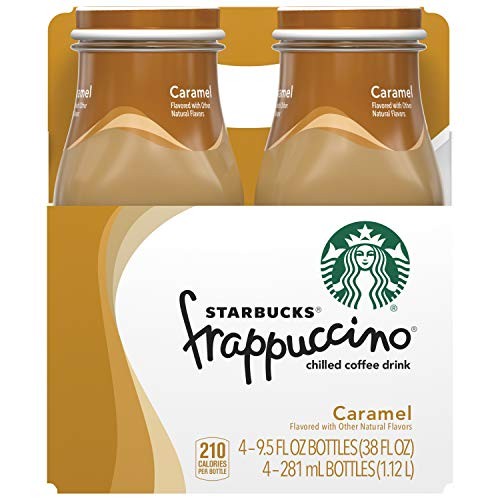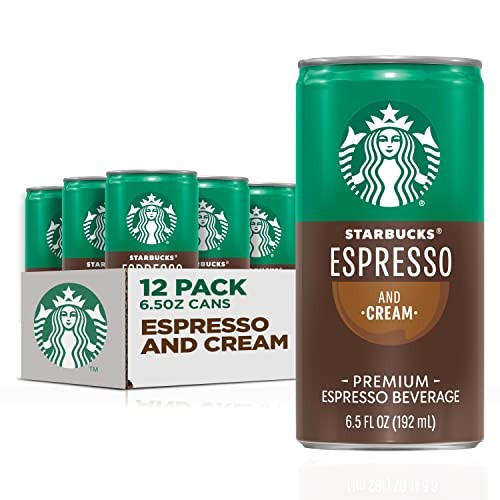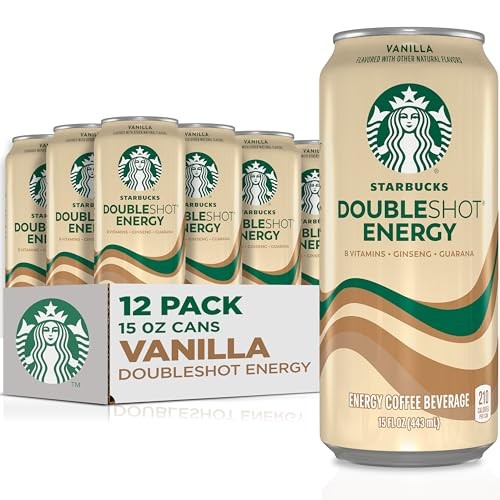How much caffeine is in a Starbucks bottled Frappuccino is a frequently asked question, and HOW.EDU.VN is here to provide you with the expert answers you need. This guide explores the caffeine content in various Starbucks Frappuccino flavors, offering clarity and insights for informed consumption, and connect you with experts in the field. Discover how much caffeine you’re really getting and make choices that align with your lifestyle.
1. Understanding Caffeine Content in Starbucks Bottled Frappuccinos
Starbucks Bottled Frappuccinos are a popular on-the-go coffee option, but the caffeine content can vary depending on the flavor. Understanding these variations is key for consumers mindful of their caffeine intake. Let’s delve into the specifics of caffeine levels in different Frappuccino flavors to help you make informed choices.
1.1. Standard Caffeine Levels in Popular Flavors
The caffeine content in Starbucks Bottled Frappuccinos can range from moderate to high, influencing your energy levels and overall experience. Knowing the specific caffeine levels in popular flavors can help you manage your daily intake effectively. Here’s a breakdown:
| Frappuccino Flavor | Caffeine Content (mg) | Bottle Size (fl oz) |
|---|---|---|
| Mocha | 110 mg | 13.7 |
| Coffee | 130 mg | 13.7 |
| Caramel | 90 mg | 13.7 |
| Vanilla | 75 mg | 13.7 |
| Almond Milk Mocha | 105 mg | 13.7 |
| Salted Dark Chocolate | 95 mg | 13.7 |
| Toasted White Chocolate | 95 mg | 13.7 |
| Caramelized Vanilla Honey | 95 mg | 13.7 |
| Dulce de Leche | 60 mg | 13.7 |



1.2. Factors Influencing Caffeine Levels
Several factors can influence the caffeine levels in bottled Frappuccinos, including the type of coffee used, the brewing process, and additional ingredients. Understanding these elements provides a deeper insight into why caffeine content varies between flavors.
- Type of Coffee: The blend and roast of coffee beans significantly affect the caffeine content. Darker roasts are often lower in caffeine compared to lighter roasts.
- Brewing Process: The method of brewing, whether it’s cold brew or espresso, can alter the amount of caffeine extracted from the coffee beans.
- Additional Ingredients: Ingredients like chocolate or added coffee extracts can either increase or balance the caffeine levels in the final product.
1.3. Comparing Caffeine Content to Other Beverages
To put the caffeine content of Starbucks Bottled Frappuccinos into perspective, it’s helpful to compare it with other common beverages. This comparison aids in understanding where Frappuccinos fall on the caffeine spectrum, allowing you to manage your consumption more effectively.
| Beverage | Caffeine Content (mg) | Serving Size (fl oz) |
|---|---|---|
| Starbucks Bottled Coffee Frappuccino | 130 mg | 13.7 |
| Red Bull | 80 mg | 8.4 |
| Coca-Cola | 35 mg | 12 |
| Monster Energy Drink | 160 mg | 16 |
| Instant Coffee | 60 mg | 8 |
2. Health Implications of Caffeine Consumption
Caffeine, a stimulant found in many beverages, has various effects on the body. Understanding these health implications can help you consume Starbucks Bottled Frappuccinos responsibly and maintain your overall well-being.
2.1. Benefits of Moderate Caffeine Intake
Moderate caffeine consumption can offer several health benefits, making it a desirable addition to your daily routine when consumed in moderation. Here are some potential advantages:
- Improved Alertness and Focus: Caffeine stimulates the central nervous system, enhancing alertness and cognitive function.
- Enhanced Physical Performance: Caffeine can improve endurance and reduce perceived exertion during physical activities.
- Mood Elevation: Caffeine can stimulate the release of dopamine, a neurotransmitter associated with pleasure and motivation, leading to an improved mood.
- Antioxidant Properties: Coffee contains antioxidants that help protect the body against cellular damage from free radicals. A study published in the “Journal of Agricultural and Food Chemistry” found that coffee is a major source of antioxidants in the diet.
2.2. Potential Risks of High Caffeine Intake
While moderate caffeine consumption can be beneficial, excessive intake can lead to several adverse effects. Understanding these risks is crucial for making informed decisions about your caffeine consumption.
- Anxiety and Insomnia: High doses of caffeine can cause anxiety, nervousness, and difficulty sleeping.
- Digestive Issues: Caffeine can increase stomach acid production, leading to heartburn, acid reflux, and other digestive problems.
- Increased Heart Rate and Blood Pressure: Excessive caffeine intake can cause a temporary increase in heart rate and blood pressure.
- Dependence and Withdrawal Symptoms: Regular high consumption of caffeine can lead to dependence, with withdrawal symptoms such as headaches, fatigue, and irritability when intake is reduced or stopped.
- Dehydration: Caffeine has a mild diuretic effect, which can lead to dehydration if fluid intake is not adequately maintained.
2.3. Recommended Daily Caffeine Limits
Health organizations generally recommend limiting caffeine intake to moderate levels. Adhering to these guidelines can help you enjoy the benefits of caffeine while minimizing potential risks. According to the Mayo Clinic, up to 400 milligrams of caffeine a day appears to be safe for most healthy adults. This is roughly the amount of caffeine in four cups of brewed coffee, two energy drinks, or several Starbucks Bottled Frappuccinos.
3. Deciphering Starbucks Bottled Frappuccino Labels
Understanding how to read and interpret Starbucks Bottled Frappuccino labels is essential for making informed choices about your caffeine and sugar intake. Decoding these labels provides valuable insights into the beverage’s contents, allowing you to align your consumption with your dietary preferences and health goals.
3.1. Identifying Caffeine Content on the Label
The caffeine content is typically listed on the nutritional information panel of the bottle, usually expressed in milligrams (mg) per serving. This information is crucial for managing your daily caffeine intake, especially if you are sensitive to stimulants or have specific health conditions. Here’s how to find it:
- Locate the Nutrition Facts: Look for the “Nutrition Facts” label on the bottle. This is usually found on the side or back of the packaging.
- Find Caffeine Information: Scan the label for caffeine content, which should be listed in milligrams (mg) per bottle.
- Check Serving Size: Note the serving size listed on the label. If you consume more than one serving, adjust the caffeine content accordingly.
3.2. Understanding Sugar and Calorie Information
In addition to caffeine, it’s important to pay attention to the sugar and calorie content in Starbucks Bottled Frappuccinos. High sugar and calorie intake can contribute to weight gain and other health issues.
- Sugar Content: The label will list the total grams of sugar per serving. Be mindful of this number, especially if you are watching your sugar intake. The American Heart Association recommends limiting added sugar intake to no more than 25 grams per day for women and 36 grams per day for men.
- Calorie Count: The label also indicates the number of calories per serving. High-calorie beverages can contribute to weight gain if consumed regularly.
3.3. Recognizing Added Ingredients and Their Effects
Starbucks Bottled Frappuccinos contain various added ingredients, such as sweeteners, stabilizers, and artificial flavors. Understanding these ingredients and their potential effects can help you make healthier choices.
- Sweeteners: Common sweeteners include sugar, high fructose corn syrup, and artificial sweeteners like sucralose. High consumption of added sugars can lead to weight gain, insulin resistance, and increased risk of chronic diseases.
- Stabilizers: Ingredients like carrageenan and cellulose gum are used to improve the texture and stability of the beverage. While generally recognized as safe, some individuals may experience digestive issues from these additives.
- Artificial Flavors: These are added to enhance the taste of the Frappuccino. Some people may be sensitive to certain artificial flavors, experiencing symptoms like headaches or allergic reactions.
4. Alternative Low-Caffeine Options
For those looking to enjoy the taste of Starbucks Frappuccinos without the high caffeine content, several low-caffeine alternatives are available. These options allow you to indulge in your favorite flavors while minimizing the stimulant effects.
4.1. Exploring Starbucks Decaf Frappuccinos
Starbucks offers decaffeinated versions of their Frappuccinos, which contain significantly less caffeine than the regular varieties. These decaf options provide a similar taste experience with reduced stimulant effects.
- Caffeine Content: Decaf Frappuccinos typically contain less than 10 mg of caffeine per serving, making them a suitable choice for those sensitive to caffeine or looking to reduce their intake.
- Flavor Variety: Decaf options are available in popular flavors like Mocha and Caramel, allowing you to enjoy your favorites without the jitters.
4.2. DIY Low-Caffeine Frappuccino Recipes
Creating your own low-caffeine Frappuccinos at home allows you to control the ingredients and caffeine levels. This DIY approach ensures you can enjoy a Frappuccino tailored to your specific preferences.
Recipe: Low-Caffeine Vanilla Frappuccino
- Ingredients:
- 1 cup of decaf coffee, brewed and chilled
- 1/2 cup of milk (dairy or non-dairy)
- 2 tablespoons of vanilla syrup
- 1 cup of ice
- Whipped cream for topping (optional)
- Instructions:
- Combine the chilled decaf coffee, milk, and vanilla syrup in a blender.
- Add the ice and blend until smooth.
- Pour into a glass and top with whipped cream if desired.
4.3. Consulting a Nutritionist for Personalized Recommendations
For personalized advice on managing your caffeine intake and finding suitable alternatives, consider consulting a nutritionist. A nutritionist can provide tailored recommendations based on your health status, dietary preferences, and lifestyle.
- Benefits of Consulting a Nutritionist:
- Personalized Advice: A nutritionist can assess your individual needs and provide tailored recommendations.
- Comprehensive Assessment: They can evaluate your overall diet and identify potential sources of excessive caffeine or sugar.
- Health Condition Management: Nutritionists can help manage health conditions like anxiety, insomnia, and digestive issues through dietary modifications.
5. Understanding Individual Caffeine Sensitivity
Individual caffeine sensitivity varies widely, influencing how different people react to the same amount of caffeine. Understanding your personal sensitivity level is essential for managing your caffeine intake and preventing adverse effects.
5.1. Factors Affecting Caffeine Sensitivity
Several factors can affect how sensitive you are to caffeine. These include genetics, body weight, tolerance, and overall health. Recognizing these factors can help you understand your unique response to caffeine.
- Genetics: Genes play a role in how quickly your body metabolizes caffeine. Some people have genes that allow them to process caffeine more rapidly, while others process it more slowly.
- Body Weight: Generally, people with lower body weights tend to be more sensitive to caffeine because the same amount of caffeine is distributed throughout a smaller body mass.
- Tolerance: Regular caffeine consumption can lead to tolerance, where the body becomes less responsive to its effects. This means you may need to consume more caffeine to achieve the same level of alertness.
- Overall Health: Certain health conditions, such as anxiety disorders and heart problems, can increase sensitivity to caffeine.
5.2. Recognizing Symptoms of Caffeine Overload
Being able to recognize the symptoms of caffeine overload is crucial for preventing serious health issues. Early detection allows you to take corrective actions and avoid further complications. Common symptoms include:
- Anxiety and Nervousness: Feeling jittery, anxious, or irritable.
- Insomnia: Difficulty falling asleep or staying asleep.
- Rapid Heartbeat: An elevated heart rate or palpitations.
- Digestive Issues: Stomach upset, nausea, or diarrhea.
- Headaches: Caffeine withdrawal headaches can occur when caffeine intake is suddenly reduced or stopped.
5.3. Monitoring Your Caffeine Intake
Keeping track of your daily caffeine consumption is a proactive way to manage your intake and avoid exceeding recommended limits. Monitoring can help you identify potential sources of excessive caffeine and make informed choices.
- Use a Caffeine Tracker App: Several mobile apps are available to help you track your caffeine intake from various beverages and foods.
- Read Labels Carefully: Always check the caffeine content listed on product labels to understand how much caffeine you are consuming.
- Keep a Diary: Maintain a daily diary to record your caffeine intake and any associated symptoms.
6. The Impact of Caffeine on Sleep Patterns
Caffeine can significantly impact sleep patterns, disrupting your ability to fall asleep and stay asleep. Understanding how caffeine affects sleep is essential for maintaining healthy sleep hygiene and ensuring restful nights.
6.1. How Caffeine Disrupts Sleep Cycles
Caffeine interferes with the body’s natural sleep-wake cycle by blocking adenosine, a neurotransmitter that promotes relaxation and sleepiness. This disruption can lead to insomnia and poor sleep quality.
- Adenosine Blockage: Caffeine binds to adenosine receptors in the brain, preventing adenosine from exerting its calming effects.
- Increased Alertness: By blocking adenosine, caffeine promotes alertness and suppresses feelings of fatigue, making it difficult to fall asleep.
- Reduced Sleep Depth: Caffeine can reduce the amount of time spent in deep sleep stages, which are essential for physical restoration and cognitive function.
6.2. Strategies for Minimizing Caffeine’s Impact on Sleep
Implementing strategies to minimize caffeine’s impact on sleep can help you maintain a healthy sleep schedule and ensure restful nights. These strategies include timing your caffeine intake, avoiding caffeine before bed, and adopting relaxation techniques.
- Time Your Caffeine Intake: Avoid consuming caffeine in the late afternoon and evening to allow your body sufficient time to metabolize it before bedtime.
- Avoid Caffeine Before Bed: Refrain from drinking caffeinated beverages at least 4-6 hours before going to sleep.
- Practice Relaxation Techniques: Engage in relaxing activities such as meditation, deep breathing exercises, or gentle yoga to promote sleepiness.
- Create a Sleep-Friendly Environment: Ensure your bedroom is dark, quiet, and cool to facilitate restful sleep.
6.3. Establishing a Healthy Sleep Routine
Creating a consistent sleep routine can help regulate your body’s natural sleep-wake cycle and improve sleep quality. A healthy sleep routine involves going to bed and waking up at the same time each day, even on weekends.
- Set a Consistent Sleep Schedule: Go to bed and wake up at the same time each day to regulate your body’s internal clock.
- Create a Relaxing Bedtime Ritual: Engage in calming activities such as reading, taking a warm bath, or listening to soothing music before bed.
- Avoid Screens Before Bed: The blue light emitted from electronic devices can interfere with sleep. Avoid using smartphones, tablets, and computers for at least an hour before bedtime.
- Ensure a Comfortable Sleep Environment: Make sure your mattress, pillows, and bedding are comfortable and supportive.
7. Expert Recommendations on Caffeine Consumption
Seeking expert advice on caffeine consumption provides valuable insights and guidance for managing your intake responsibly. Experts in nutrition and health can offer tailored recommendations based on your individual needs and health goals.
7.1. Guidelines from Nutritionists and Dietitians
Nutritionists and dietitians provide evidence-based recommendations on caffeine consumption, emphasizing moderation and awareness. Their guidelines help you make informed choices and prevent potential health issues.
- Moderation: Consume caffeine in moderation, typically no more than 400 mg per day for healthy adults.
- Awareness: Be aware of the caffeine content in various beverages and foods, and track your daily intake.
- Individual Needs: Consider your individual sensitivity to caffeine and adjust your intake accordingly.
- Hydration: Drink plenty of water to counteract the diuretic effects of caffeine and maintain hydration.
7.2. Medical Advice for Specific Health Conditions
Individuals with certain health conditions, such as anxiety disorders, heart problems, and digestive issues, should seek medical advice regarding caffeine consumption. Healthcare providers can offer tailored recommendations based on your specific health needs.
- Anxiety Disorders: Caffeine can exacerbate anxiety symptoms. Individuals with anxiety disorders should limit or avoid caffeine intake.
- Heart Problems: High caffeine intake can increase heart rate and blood pressure. People with heart problems should consult their doctor about safe caffeine levels.
- Digestive Issues: Caffeine can irritate the digestive system. Individuals with digestive issues should monitor their caffeine intake and avoid consuming it on an empty stomach.
- Pregnancy: Pregnant women should limit their caffeine intake to no more than 200 mg per day to minimize the risk of adverse effects on the fetus.
7.3. Utilizing HOW.EDU.VN for Expert Consultations
HOW.EDU.VN offers a platform to connect with leading experts and receive personalized advice on managing your caffeine consumption. Our team of experienced professionals is dedicated to providing evidence-based guidance tailored to your unique needs.
- Access to Leading Experts: Connect with nutritionists, dietitians, and healthcare providers through our platform.
- Personalized Consultations: Receive tailored recommendations based on your health status, dietary preferences, and lifestyle.
- Evidence-Based Guidance: Benefit from evidence-based advice and strategies for managing your caffeine intake responsibly.
- Comprehensive Support: Access a wide range of resources and support tools to help you achieve your health goals.
8. Debunking Common Caffeine Myths
Several myths surround caffeine consumption, leading to misconceptions about its effects and safety. Debunking these myths is crucial for making informed decisions and adopting a balanced approach to caffeine intake.
8.1. Myth: Caffeine is Always Harmful
Fact: While excessive caffeine intake can have negative effects, moderate consumption can offer several health benefits, such as improved alertness, enhanced physical performance, and mood elevation. The key is to consume caffeine in moderation and be mindful of your individual sensitivity.
8.2. Myth: Caffeine is Addictive
Fact: Caffeine can lead to dependence, where regular consumption results in withdrawal symptoms when intake is reduced or stopped. However, it is not considered as addictive as substances like nicotine or alcohol. Withdrawal symptoms are typically mild and temporary, such as headaches, fatigue, and irritability.
8.3. Myth: All Caffeinated Beverages are the Same
Fact: The caffeine content in different beverages varies widely. For example, a cup of brewed coffee typically contains more caffeine than a can of soda or a cup of tea. Additionally, other ingredients in caffeinated beverages, such as sugar and artificial additives, can have different effects on your health.
8.4. Myth: Caffeine Can Counteract the Effects of Alcohol
Fact: Caffeine does not counteract the effects of alcohol. While caffeine can make you feel more alert, it does not reduce the impairment caused by alcohol. Combining caffeine and alcohol can be dangerous, as it may mask the sedative effects of alcohol and lead to overconsumption.
9. Staying Informed with the Latest Research on Caffeine
Staying up-to-date with the latest research on caffeine is essential for making informed decisions about your consumption habits. Scientific studies continually provide new insights into the effects of caffeine on health and well-being.
9.1. Following Reputable Sources of Information
Relying on reputable sources of information, such as scientific journals, health organizations, and academic institutions, ensures that you are receiving accurate and evidence-based information about caffeine.
- Scientific Journals: Publications like the “Journal of the American Medical Association” (JAMA) and the “American Journal of Clinical Nutrition” publish peer-reviewed studies on the effects of caffeine.
- Health Organizations: Organizations such as the World Health Organization (WHO) and the Mayo Clinic provide guidelines and recommendations on caffeine consumption based on scientific evidence.
- Academic Institutions: Universities and research institutions conduct studies on caffeine and its effects on health.
9.2. Understanding Scientific Studies on Caffeine
Understanding the basics of scientific studies on caffeine can help you critically evaluate research findings and draw informed conclusions.
- Study Design: Pay attention to the study design, such as whether it is a randomized controlled trial, cohort study, or cross-sectional study. Randomized controlled trials are considered the gold standard for evaluating the effects of interventions.
- Sample Size: Consider the sample size of the study. Larger sample sizes generally provide more reliable results.
- Control Groups: Look for studies that include control groups to compare the effects of caffeine with a placebo or other intervention.
- Peer Review: Ensure that the study has been peer-reviewed by experts in the field.
9.3. Applying Research Findings to Your Lifestyle
Applying research findings to your lifestyle involves translating scientific evidence into practical strategies for managing your caffeine intake and promoting your overall health.
- Assess Your Caffeine Intake: Evaluate your current caffeine consumption and identify potential sources of excessive intake.
- Adjust Your Habits: Modify your caffeine consumption habits based on research findings and expert recommendations.
- Monitor Your Health: Pay attention to any changes in your health or well-being that may be related to caffeine consumption.
10. Conclusion: Making Informed Choices About Starbucks Bottled Frappuccinos
Making informed choices about Starbucks Bottled Frappuccinos involves understanding the caffeine content, health implications, and individual sensitivities. By staying informed and seeking expert advice, you can enjoy these beverages responsibly and maintain your overall well-being.
10.1. Recap of Key Points
- Caffeine Content: Starbucks Bottled Frappuccinos vary in caffeine content, ranging from 60 mg to 130 mg per bottle.
- Health Implications: Moderate caffeine intake can offer benefits, while excessive consumption can lead to adverse effects.
- Label Reading: Understanding product labels helps you manage your caffeine, sugar, and calorie intake.
- Low-Caffeine Options: Decaf Frappuccinos and DIY recipes provide low-caffeine alternatives.
- Individual Sensitivity: Recognizing your personal caffeine sensitivity is crucial for preventing adverse effects.
- Sleep Patterns: Caffeine can disrupt sleep; strategies to minimize its impact include timing intake and establishing a healthy sleep routine.
- Expert Recommendations: Consulting nutritionists and healthcare providers offers tailored advice for managing caffeine consumption.
- Caffeine Myths: Debunking common myths ensures informed decision-making about caffeine.
- Staying Informed: Following reputable sources of information and understanding scientific studies promotes responsible consumption.
10.2. Encouragement to Seek Expert Advice
We encourage you to seek expert advice from nutritionists and healthcare providers to develop a personalized strategy for managing your caffeine intake. At HOW.EDU.VN, we connect you with experienced professionals who can provide tailored guidance and support to help you achieve your health goals.
10.3. Call to Action: Contact HOW.EDU.VN for Personalized Guidance
Do you have questions about managing your caffeine intake or need personalized advice on finding suitable alternatives? Contact HOW.EDU.VN today to connect with our team of leading experts. Our dedicated professionals are ready to provide you with the evidence-based guidance and support you need to make informed choices and maintain your overall well-being.
Address: 456 Expertise Plaza, Consult City, CA 90210, United States
WhatsApp: +1 (310) 555-1212
Website: HOW.EDU.VN
Let how.edu.vn be your trusted partner in achieving your health goals. Contact us today and take the first step towards a healthier, more informed lifestyle.
